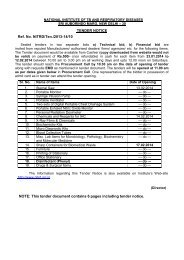The Indian Journal of Tuberculosis - LRS Institute of Tuberculosis ...
The Indian Journal of Tuberculosis - LRS Institute of Tuberculosis ...
The Indian Journal of Tuberculosis - LRS Institute of Tuberculosis ...
You also want an ePaper? Increase the reach of your titles
YUMPU automatically turns print PDFs into web optimized ePapers that Google loves.
132<br />
P.G. GOPI ET AL<br />
and cure (Table 3). In multivariate analysis, holding<br />
review meeting was independently associated with<br />
conversion and cure. Availability <strong>of</strong> LT was an<br />
additional factor found to be independently associated<br />
with cure.<br />
DISCUSSION<br />
<strong>The</strong> main finding <strong>of</strong> our study was that<br />
the programme performance varied between the HFs<br />
in the area over the years and for the first time we<br />
are able to correlate the functioning <strong>of</strong> HF with<br />
programme performance. Factors that influence the<br />
indicators are regular availability <strong>of</strong> essential staff<br />
such as MO, LT, regular supervisory visits <strong>of</strong> field<br />
staff, and review <strong>of</strong> DOTS activities. Availability <strong>of</strong><br />
VHN and Pharmacist appeared to have not<br />
contributed significantly towards improving the<br />
conversion and cure. This could be due to the<br />
decentralization <strong>of</strong> the DOTS activities and hence<br />
their availability would not have contributed much.<br />
In block A, redeployment <strong>of</strong> staff for the<br />
speciality health camps conducted might have<br />
affected the DOTS performance. <strong>The</strong> absence <strong>of</strong> a<br />
MO and lack <strong>of</strong> review meeting might have<br />
contributed to poor performance in some <strong>of</strong> the HFs<br />
for 2001. Speciality health camps and lack <strong>of</strong> regular<br />
review meetings might have contributed for the suboptimal<br />
performance <strong>of</strong> B3 in 2001. In HF B2, lack<br />
<strong>of</strong> MO, review meetings and supervision in the year<br />
2002 were found to be the factors that might have<br />
contributed for a poor performance in 2002. In HF<br />
C1, patients not belonging to the area were started<br />
on treatment, resulting in high default. In HF C2,<br />
there was no permanent MO for 8 months and<br />
adequate training was not given for those posted<br />
temporarily. In HF C4, the MO was deputed for<br />
health camp. <strong>The</strong> performance improved from 2002<br />
due to the posting <strong>of</strong> regular MO and regular review<br />
meetings. In HF C3, there was no permanent MO in<br />
2003 and hence no supervisory field visit was made<br />
during this year. <strong>The</strong> low conversion and cure rates<br />
in block D for the year 2000 might be due to the<br />
poor performance <strong>of</strong> D1 and D3. In HF D1, the<br />
MO in-charge was transferred and there was no<br />
review on DOTS activities. In 2001, the<br />
performance improved but decreased further due to<br />
frequent transfers <strong>of</strong> MOs and posting <strong>of</strong> MO who<br />
was not trained in DOTS. In HF D3, MOTC did no<br />
field visit throughout the year 2000. <strong>The</strong>re was no<br />
pharmacist for four months. <strong>The</strong> performance<br />
improved in the subsequent two years. In 2003, the<br />
non-availability <strong>of</strong> MO and diversion from the DOTS<br />
activities, might have contributed to the slight<br />
reduction in cure and conversion. All HFs <strong>of</strong> the block<br />
E performed well except HF E2 where there was<br />
slight decline in the cure rate for 2001. This was<br />
due to migration <strong>of</strong> patients to the neighboring state.<br />
HFs A1, A4, B1, B2, C3, and D2 had performed<br />
better since the supervision and review meetings were<br />
regular in these areas.<br />
<strong>The</strong>re is an existing comprehensive system<br />
<strong>of</strong> monitoring <strong>of</strong> RNTCP based on indicators that<br />
have international acceptance. <strong>The</strong>re is a need to<br />
emphasize the need for periodic evaluation <strong>of</strong> the<br />
functioning <strong>of</strong> each HFs and outreach <strong>of</strong> services to<br />
the patients to ensure that the programme is well<br />
functioning with adequate staff and other<br />
functionaries to achieve the expected level <strong>of</strong> cure<br />
and conversion 6 . Keeping these in mind, we have<br />
attempted to identify HFs not functioned optimally<br />
that might have resulted in low conversion and cure<br />
rates.<br />
In our series, there was a correlation<br />
between good performance <strong>of</strong> HFs and the<br />
availability <strong>of</strong> supervisory staff at the HF,<br />
supervision and conduct <strong>of</strong> review meeting. <strong>The</strong>re<br />
was a mutual relationship between activities <strong>of</strong><br />
the HFs in terms <strong>of</strong> functional scores and<br />
programme indicators. <strong>The</strong> correlation coefficient<br />
<strong>of</strong> 0.8 each obtained between functional<br />
score and conversion; and functional score and<br />
cure was a quantitative expression <strong>of</strong> the<br />
similarity between HF activities and success <strong>of</strong><br />
the TB programme. In general, there was a<br />
significant increase in trend for both conversion<br />
and cure based on the functional score.<br />
TB can be controlled only with effective<br />
supervision and efficient management. One <strong>of</strong> the<br />
major weaknesses <strong>of</strong> the earlier national TB control<br />
programme <strong>of</strong> India identified in 1992 7 , was lack <strong>of</strong><br />
supervision. Though, in RNTCP adequate emphasis<br />
<strong>Indian</strong> <strong>Journal</strong> <strong>of</strong> <strong>Tuberculosis</strong>
















